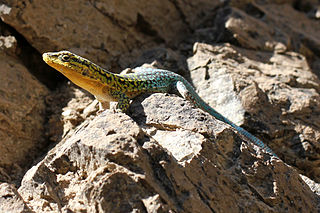
Liolaemus is a genus of iguanian lizards, containing many species, all of which are endemic to South America.
Liolaemus rabinoi, commonly known as Rabino's tree iguana, is a species of lizard in the family Iguanidae or the family Liolaemidae. The species is endemic to Argentina.

Liolaemus umbrifer is a species of lizard in the family Liolaemidae. It is endemic to the Catamarca Province in northwestern Argentina.
Liolaemus acostai is a species of lizard in the family Liolaemidae. The species is endemic to Argentina.
Liolaemus aparicioi is a species of lizard in the family Liolaemidae. The species is endemic to Bolivia.
Liolaemus avilae is a species of lizard in the family Liolaemidae. The species is endemic to Argentina.
Liolaemus azarai is a species of lizard in the family Liolaemidae. The species is native to Argentina and Paraguay.
Liolaemus boulengeri, also known commonly as Boulenger's tree iguana, is a species of lizard in the family Liolaemidae. The species is endemic to Argentina.
Liolaemus brizuelai is a species of lizard in the family Liolaemidae. The species is endemic to Argentina.
Liolaemus buergeri, also known commonly as Buerger's tree iguana, is a species of lizard in the family Liolaemidae. The species is native to Argentina and Chile.
Liolaemus cazianiae is a species of lizard in the family Liolaemidae. The species is endemic to Argentina.
Liolaemus donosobarrosi, also known commonly as Donoso-Barros' tree iguana, is a species of lizard in the family Liolaemidae. The species is endemic to Argentina.
Liolaemus dorbignyi, also known commonly as D'Orbigny's tree iguana, is a species of lizard in the family Liolaemidae. The species is endemic to South America.
Liolaemus duellmani, also known commonly as Duellman's tree iguana, is a species of lizard in the family Liolaemidae. The species is endemic to Argentina.
Liolaemus espinozai is a species of lizard in the family Liolaemidae. The species is native to Argentina.
Liolaemus fitzgeraldi, also known commonly as Fitzgerald's tree iguana and la lagartija de Aconcagua, is a species of lizard in the family Liolaemidae. The species is native to southwestern South America.
Liolaemus goetschi is a species of lizard in the family Liolaemidae. The species is endemic to Argentina.

Liolaemus gracielae is a species of lizard in the family Liolaemidae. The species is endemic to Argentina.
Liolaemus grosseorum is a species of lizard in the family Liolaemidae. The species is endemic to Argentina.
Liolaemus puelche is a species of lizard in the family Liolaemidae. The species is endemic to Argentina.



